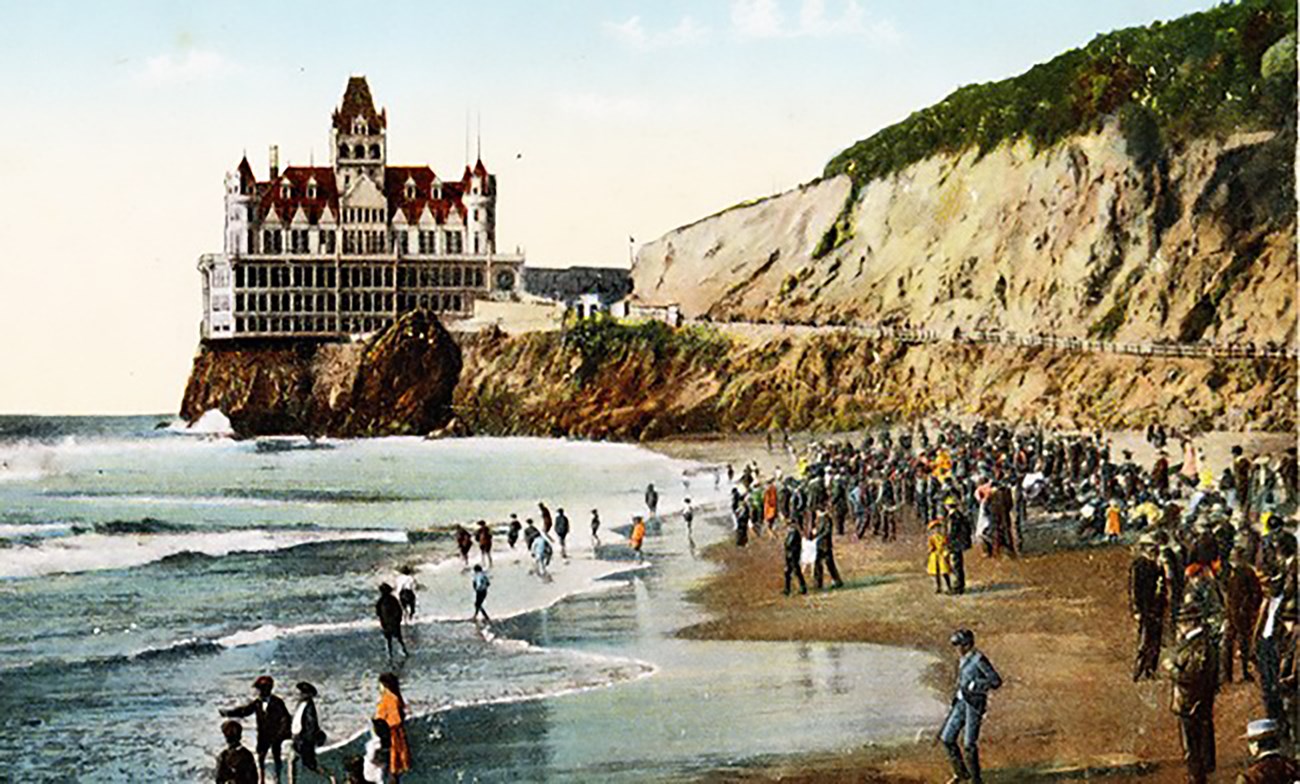
C.C. Butler and Senator John Buckley opened the first Cliff House in 1863. The restaurant was housed in a modest structure perched on the cliff at the end of Point Lobos Road. Under Captain Junius Foster, the establishment became a destination for the city’s wealthy and high profile visitors. They remodeled the Cliff House in 1868 to include a promenade and two wings. The Cliff House became a favorite meeting place of politicians as well as more undesirable members of the population. Some of the disreputable clientele scared off the high society customers and soon the Cliff House became known for indecent behavior. Adolph Sutro bought the Cliff House in 1883 and unsuccessfully tried to revamp the restaurant himself. In 1885, he leased the restaurant to J.M. Wilkins who restored the Cliff House’s reputation, reclaiming its place as a tourist destination and respectable establishment for tourists and locals alike. 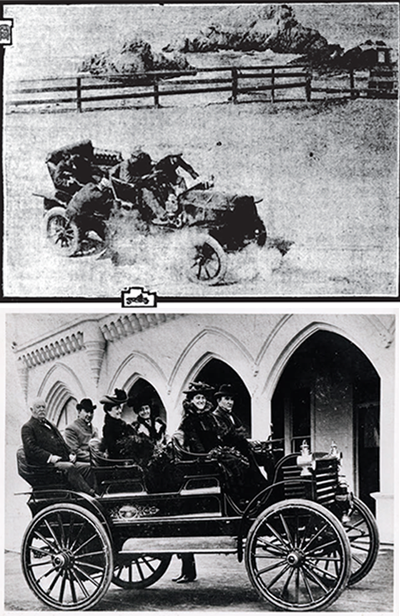
Automobiles at Lands EndIn March 1900, a group of automobilists gathered at the Cliff House to create the Automobile Club of California, which later became the California State Automobile Association (CSAA). The club was organized to promote the automobile, help drivers get to their destinations “with greater comfort, safety and convenience, “and to encourage drivers not to abuse the privileges they had been granted as motorists. J.M. Wilkins, proprietor of the Cliff House, was the club’s secretary and meetings were held on a regular basis at his establishment. The CSAA petitioned the Park Commission for more access throughout the city.Automobiles were allowed to drive through Golden Gate Park in 1904 and the portion of Cliff Avenue that connected to the Great Highway was opened to autos in 1907. The Cliff House was often the end point in auto runs organized by the club and continued to be the club’s monthly meeting place. The steep grade and winding curves of Cliff Avenue and the scenic views and straightaway of the Great Highway is still a draw for adventurous motorists. As the automobile gradually became the preferred mode of transportation, Lands End made changes for its accommodation: Cliff Ave. was widened, garages were built across from the Cliff House, and the hillside was terraced and paved for parking lots. 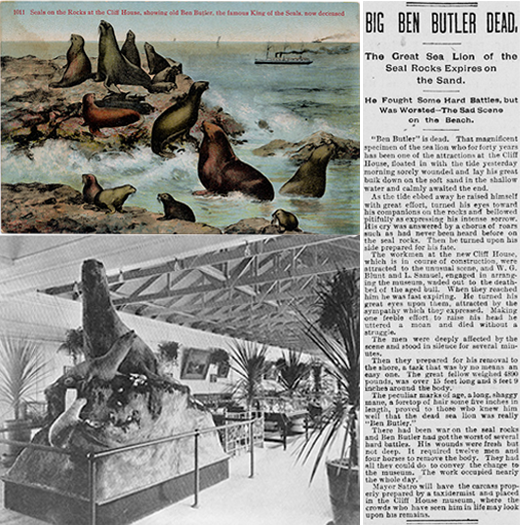
Ben ButlerOn a visit to the Cliff House in the early 1860s, Horace Greeley, a famous newspaper publisher, spotted a huge sea lion on Seal Rocks. He dubbed the creature, Ben Butler, after the Civil War general.As time went by Ben Butler became almost as famous as Seal Rocks themselves and tourists always hoped to catch a glimpse of the hefty 4,890 lb., “King of the Seals”. Ben Butler died in 1895 after a vicious battle with another male sea lion. His death was featured in many major newspapers. This celebrity was then stuffed and displayed at Sutro Baths. 
Cliff House Suspension BridgeIn the 1880s, a rope and wood bridge linked the Cliff House to one of the Seal Rocks known as Flag Rock. It hung 25-30 feet above the sand or shallow water depending on the tide and provided a close and dramatic view of the pounding waves.In April 1884, several boys rocked the bridge so rigorously that it flipped upside down, throwing 35-40 people to the sand and shallow water below, seriously injuring several of them. The bridge was not repaired, and visitors returned to admiring Seal Rocks from afar. 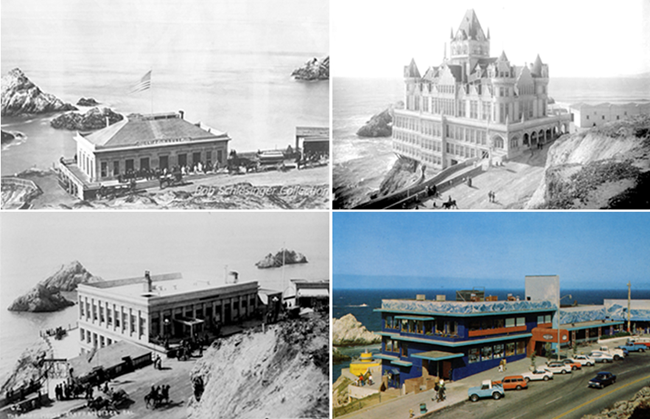
Cliff House ArchitectureEach new remodel dramatically changed the look of the Cliff House. The 1863 Cliff House was a modest building that looked like the home of some prosperous citizen. In 1868, the building tripled in size. Two wings were added, and a castle-like archway built over the entrance to the balcony that surrounded the building.After the original Cliff House burned in 1894, Adolph Sutro built the most extravagant version of this local monument. Sutro’s ornate Victorian Cliff House had eight stories, four spires, countless turrets and decorative moldings, and an observation tower. Though Sutro’s Cliff House was a must-see San Francisco attraction, it was ridiculed and thought of as an architectural eyesore by some. The Victorian Cliff House also fell victim to fire, in 1907. The third Cliff House was erected by Sutro’s daughter Emma and was built in a neoclassical style of reinforced steel and poured concrete. In 1937, neon signs were erected by new owner George Whitney. The Cliff House was remodeled in 1949 and a “modern” redwood façade added to the building’s exterior. In the 1970s, the redwood façade was painted blue, complete with frothy waves. In 2004, the Cliff House was once again remodeled in a modern style that accentuates the natural beauty of its surroundings and restores some of the building’s original neoclassical elements. 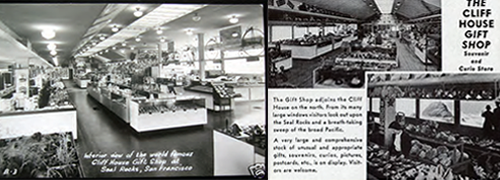
Cliff House Gift ShopGift ShopThe first Cliff House gift shop opened in the late 1800s during the time of Adolph Sutro’s Victorian Cliff House. Over the years, as the Cliff House underwent countless remodels, renovations, and a fire, the gift shop went through numerous location changes and ownerships.The gift shop opened by the Whitney Brothers in 1939, adjacent to the Cliff House at 1066 Point Lobos Road, claimed to be the largest in the world during the 1940s and 50s. Accordingly, it was stocked with every souvenir and memento imaginable. In the 1970s, the gift shop was moved inside the Cliff House. Its famous Christmas Shop became a popular shopping destination amongst locals. Today the shop is located in the Sutro Wing of the renovated Cliff House and still offers a variety of gifts and souvenirs. In 2012, competition arrived in the form of the Lands End Lookout visitor’s center. 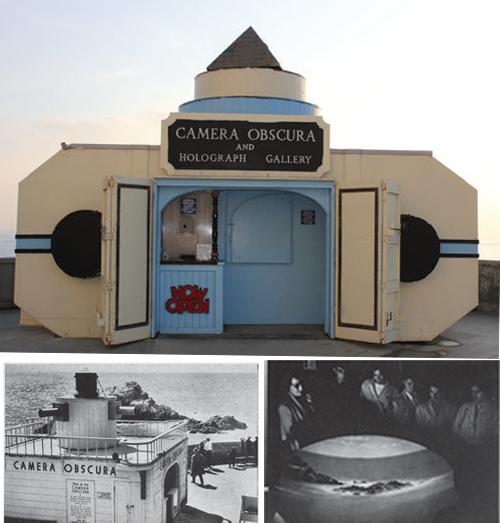
Camera ObscuraAn invention that eventually led to photography, the camera obscura, is an optical device used for entertainment and drawing. The device is built using a box or a room with a small hole that lets light in. The light from an outside image passes through the hole and is projected upside-down but in scale as it strikes an inside surface. Oftentimes, mirrors or reflective discs can be used to produce a right-side-up image.The Jennings’ Giant Camera Obscura was built in 1946 by Floyd Jennings on the observation deck of the Cliff House. Since then, visitors to the Cliff House have been awed by live images of Seal Rocks projected onto the giant parabolic disc that sits in the center of the room. The camera was built as an extension of Playland-at-the-Beach but remained after the amusement park closed. Its exterior was remodeled in 1957 to resemble a giant camera. It was listed on the National Register of Historic Places in 2001 as a rare example of its type. The camera is located on the Cliff House balcony and continues to amuse visitors of all ages. 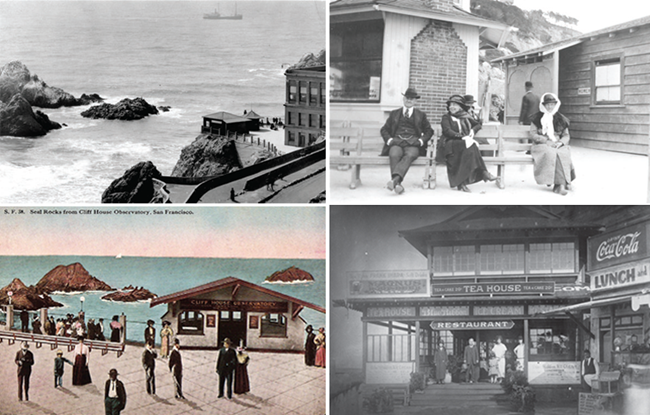
Cliff House Terrace ConcessionsEvery new version of the Cliff House included a terrace or observation deck that ran around the west of the building, offering great views of the Pacific Ocean. The third incarnation of the building, built by Sutro’s daughter, Emma Sutro Merritt, charged a 10-cent admission fee to its terrace.During the 1910s, 1920s, and into the 1930s, a variety of small buildings appeared on the terrace and admission was no longer charged. The buildings housed a Japanese tea house, waffle and ice cream stand, a peanut stand, sandwich and hot dog stand, an information kiosk, a restroom, located where the Camera Obscura stands today, and the Cliff House Observatory, from which guests could rent binoculars or view Seal Rocks through telescopes. Several 1920s City Directories list the Stavrou family as owners of a lunch, candies, and fruits and vegetable business on the terrace. The Japanese tea house was run by Sadikichi Ihara. It seems the terrace businesses were evicted when the Whitney Brothers took over the Cliff House in 1937. 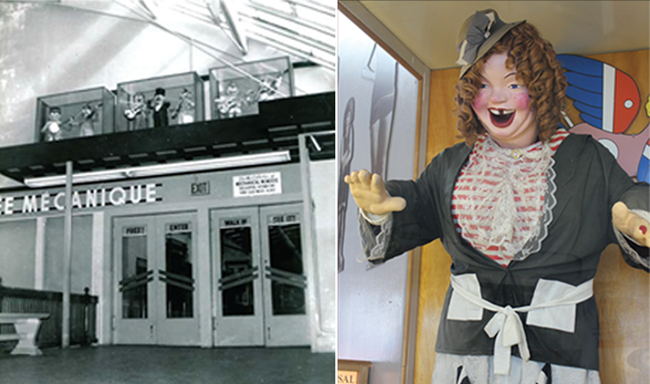
Musée MécaniqueThe Musée Mécanique is a museum of antique coin-operated mechanical amusements. Its collection features over 300 items, including arcade games, music boxes, player pianos, fortune-telling machines, motion pictures, peep shows, animated dioramas, and photo booths, as well as the beloved (yet terrifying)Laffing Sal, who moved to the museum from the Playland Fun House when the amusement park was dismantled in 1972. One of the Musee’s antique mutoscopes (an early motion picture machine that works like a flip book) was installed at the Lands End Lookout visitor’s center in 2012, showcasing stereocard images of Lands End. Originally housed in the Sutro Baths, the museum eventually found a home in the basement of the Cliff House. The Musée Mécanique was moved to its current space at the end of Pier 45 in San Francisco by its owner Edward Zelinsky in 2002 when the Cliff House was remodeled. 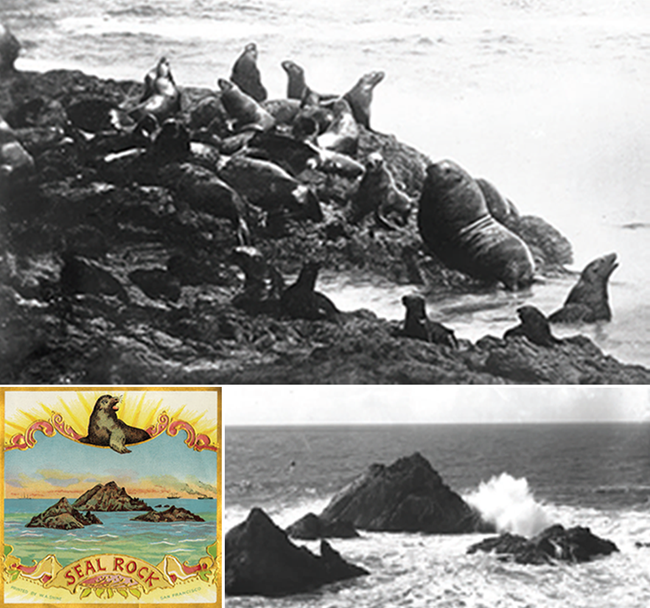
Seal RocksThese rocky islets that lie off the shore below the Cliff House were once home to hundreds of sea lions. Visitors to Lands End walked the Cliff House balcony to view the creatures, hoping to catch a glimpse of the biggest, most famous sea lion of all -- Ben Butler.Seal Rocks were also the focus of many public spectacles. Wires were strung between the Cliff House and the Rocks for several famous tightrope walks. Racing swimmers navigated their way around the outcrops. At the urging of Adolph Sutro, Congress granted Seal Rocks to the City of San Francisco in 1887, essentially becoming one of the nation’s first congressionally designated marine sanctuaries. The City was charged with keeping Seal Rocks, “free from encroachment by man and preserve from molestation the seals and other animals now accustomed to resort there”. After the 1989 Loma Prieta earthquake, the sea lions moved to Pier 39 in San Francisco. They began to return in the mid 1990s, taking up residence in summer and staying into the fall. Even without a huge sea lion population Seal Rocks provide visitors with a picturesque view of the Pacific horizon. 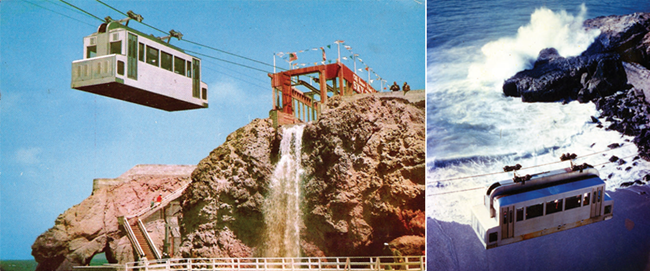
Sky TramThe Whitney Sky Tram opened in 1955, offering rides between the Cliff House terrace to Point Lobos for 25 cents each way. The tram was suspended on cables 1000 feet over the surf, and held up to 25 people for a 4 minute one-way ride. Two man-made waterfalls, said to be the world’s largest salt water falls, awaited on the Point Lobos promontory.Fog and wind sometimes made for a frightening ride. After a few years of operation the tram also became rusty and weathered, adding another element of danger to the ride. But without the exciting weather conditions and rusty equipment the tram was said to be rather boring. High maintenance costs and low ridership doomed the Sky Tram. It closed in the mid-1960s, operating for less than a decade. The Sky Tram station at Point Lobos served as the Golden Gate National Recreation Area visitor’s center for many years after the tram was closed. The building was removed during the 2004 Cliff House renovations. 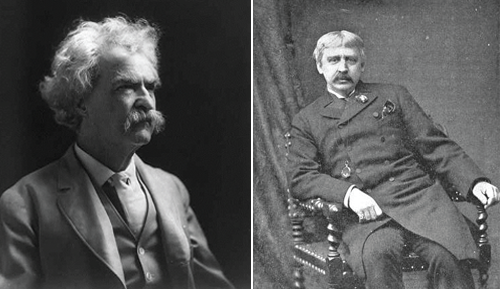
Writers and the Cliff HouseThe dramatic surroundings and exciting events at the Cliff House have inspired writers, artists, and poets for over a century.San Francisco literary circles in the 1860s and 1870s included writers such as Mark Twain, Ambrose Bierce, Ina Coolbrith, Joaquin Miller, Prentice Mulford, and Bret Harte, who described early California dialect, ways of life, landscapes, and characters. Satirist, poet, editor, and short story writer,Bret Harte, was a dominant figure among this circle of writers, who mastered the art of Gold Rush fiction. Harte wrote “Legend of the Cliff House”, a poem about James Cooke’s 1865 tightrope walk to Seal Rocks. Mark Twain, during an 18-week stint as a full time reporter for the Morning Call, wrote one of his first articles about visiting the Cliff House. In June 1864 he wrote, “If one tire of the drudgeries and scenes of the city, and would breathe the fresh air of the sea, let him take the cars and omnibuses, or, better still, a buggy and pleasant steed, and, ere the sea breeze sets in, glide out to the Cliff House”. To learn about other Lands End vestiges and stories, please visit the main Vestiges of Lands End page. |
Last updated: May 12, 2022
